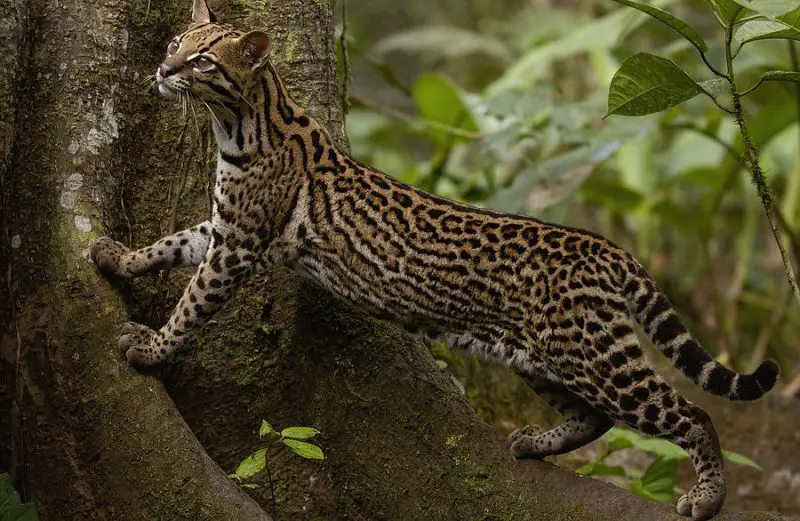The ocelot, scientifically known as Leopardus pardalis, is one of North America’s most intriguing wild cats. Texas is the only U.S. state where these elusive felines are still found in the wild, primarily in the southernmost regions along the Rio Grande. Renowned for their striking coats and solitary nature, ocelots inspire fascination among wildlife enthusiasts, photographers, and conservationists. Despite their rarity, these cats play an important ecological role, and understanding their behavior and habitat is key to supporting their survival.
This article explores ocelots in Texas in detail, focusing on identification, physical characteristics, behavior, diet, habitat, distribution, and where to see them. It also highlights the challenges they face and the conservation efforts aimed at preserving their dwindling populations.
Ocelot Identification in Texas

Physical Characteristics
Ocelots are medium-sized cats with a distinctive, beautifully patterned coat. Their fur varies from golden yellow to reddish-brown, adorned with black rosettes, elongated spots, and stripes. Each ocelot has a unique pattern, which researchers often use to identify individuals. Their sleek, muscular bodies are designed for stealth and agility, enabling them to move quietly through dense vegetation.
The body of an adult ocelot typically measures between twenty-eight and thirty-five inches in length, with a tail adding another ten to sixteen inches. Weight usually ranges from fifteen to thirty pounds. They have rounded ears marked with prominent white spots, which are believed to assist in communication between cats in dense habitats. Their sharp claws and powerful limbs allow them to climb trees and navigate thick underbrush efficiently.
Comparison With Other Wild Cats
Many people confuse ocelots with bobcats due to their similar size and habitat. However, bobcats have shorter tails, tufted ears, and more muted coat patterns, while ocelots possess long ringed tails, rounded ears, and vividly patterned fur. Mountain lions, which also inhabit Texas, are much larger and have solid tan coats, making them easily distinguishable from the smaller, spotted ocelot. These differences help wildlife enthusiasts and biologists accurately identify ocelots in the wild.
Ocelot Behavior and Lifestyle
Solitary and Elusive
Ocelots are naturally solitary, only coming together for mating or when mothers raise their kittens. They establish territories, with males typically having larger ranges than females. While these ranges may overlap, ocelots actively avoid direct contact with others to reduce conflict. Their nocturnal nature makes daytime observation rare, as they rest under dense brush and rely on their camouflage to remain hidden from predators and humans.
Hunting and Feeding
Ocelots are carnivorous and primarily feed on small to medium-sized mammals, birds, and reptiles. In Texas, their diet includes rabbits, rodents, armadillos, and various bird species. Occasionally, they will prey on reptiles and amphibians if the opportunity arises. Unlike predators that chase prey over long distances, ocelots rely on ambush tactics, stalking their target silently before pouncing with precision. Their hunting behavior ensures a high success rate while conserving energy, making them efficient and stealthy predators.
Reproduction and Lifespan
Ocelots breed throughout the year, though most births in Texas occur during spring and summer. Females give birth to one to three kittens after a gestation period of approximately seventy to eighty days. The kittens are born blind and entirely dependent on their mother. They remain with her for up to two years, learning essential hunting and survival skills before establishing their own territories. In the wild, ocelots typically live seven to ten years, though some can survive longer in protected environments.
Habitat of Ocelots in Texas
Preferred Environments
Ocelots in Texas prefer dense thornscrub forests, coastal prairies, and areas with thick brush cover. This type of vegetation provides both camouflage and safe spaces for raising young. Their habitat is often dominated by native plants such as mesquite, prickly pear cactus, and huisache trees. These plants create the dense thickets that ocelots use to remain hidden while hunting or resting. Open fields and urbanized areas are generally avoided, as ocelots rely heavily on cover for survival and protection.
Historical and Current Range
Historically, ocelots were found throughout Texas, Arizona, and parts of the southern United States. Today, their presence is largely restricted to the Lower Rio Grande Valley of southern Texas. Populations are concentrated in counties such as Starr, Willacy, Cameron, and Hidalgo. Habitat destruction due to agriculture, urban expansion, and road development has drastically reduced their range, leaving these southern regions as one of the last viable strongholds for the species in the United States.
Distribution and Where to See Ocelots in Texas
Key Locations
The Lower Rio Grande Valley is the best region to observe ocelots in Texas. The Laguna Atascosa National Wildlife Refuge in Cameron County provides some of the densest habitat, supporting one of the last known breeding populations of ocelots in the U.S. These dense brushlands offer cover for hunting and safe dens for raising young.
Private ranchlands also provide essential habitats for ocelots. In areas where brush is preserved and land management practices prioritize wildlife, ocelots continue to survive. However, sightings are extremely rare due to the cat’s secretive, nocturnal habits. Most encounters in the wild are fleeting, and many individuals are only detected through camera traps or other monitoring equipment.
Challenges in Observation
Observing an ocelot in the wild requires patience and persistence. Their nocturnal activity, elusive nature, and preference for dense cover make direct sightings uncommon. Even in prime habitats, wildlife enthusiasts often spend days or weeks without encountering one. Educational programs and wildlife footage provide alternative ways to appreciate these cats for those unable to see them in person.
Diet and Hunting Strategies
Feeding Patterns
Ocelots consume a variety of prey depending on availability. Their diet in Texas primarily consists of cotton rats, cottontail rabbits, opossums, armadillos, and small birds. Occasionally, they will take reptiles, such as lizards and snakes. By preying on small mammals and birds, ocelots help regulate populations and maintain balance within the ecosystem.
Hunting Behavior
Ocelots rely on patience and stealth to capture prey. They move quietly through brush, crouching low to remain hidden, and then strike quickly with a powerful leap. Small prey is dispatched with a swift bite to the neck, while larger animals may require a struggle. Unlike predators that chase over long distances, ocelots conserve energy and focus on ambush hunting, relying on speed, agility, and precision to secure a meal.
Conservation Status of Ocelots in Texas
Endangered Species
The U.S. Fish and Wildlife Service classifies ocelots as endangered. Fewer than 120 individuals are believed to survive in Texas, making them one of the rarest wild cats in the country. Habitat loss, vehicle collisions, and limited genetic diversity pose the greatest threats. Roads that cut through brushlands fragment territories, reducing the ability of ocelots to find mates and maintain healthy populations.
Conservation Efforts
Conservation programs in Texas aim to preserve and restore thornscrub habitats. The Laguna Atascosa National Wildlife Refuge is a key focus, where biologists monitor populations, protect dens, and restore native vegetation. Collaboration with private landowners is equally crucial, as ranches that maintain dense brush provide critical habitat corridors for ocelots.
Cross-border conservation efforts with Mexico are vital because Texas ocelots are genetically linked to populations in northeastern Mexico. Maintaining habitat connectivity ensures genetic diversity and supports long-term survival. Public awareness campaigns also highlight the importance of preserving these cats and encourage community involvement in conservation initiatives.
Fascinating Facts About Ocelots
Ocelots are excellent climbers and swimmers, which allows them to navigate diverse environments with ease. They produce a wide variety of vocalizations, including growls, meows, and yowls, each serving different purposes in communication. Known as “painted leopards” for their intricate markings, ocelots have a unique charm that distinguishes them from other wild cats. Beyond their ecological role, ocelots hold cultural significance, historically admired by Indigenous communities as symbols of strength and stealth.
FAQs About Ocelots in Texas
Are there wild ocelots in Texas?
Texas is the only U.S. state with a surviving population of wild ocelots, primarily concentrated in the Lower Rio Grande Valley.
How many ocelots remain in the state?
Current estimates suggest fewer than 120 individuals remain in Texas, making them critically endangered.
Where is the best place to see ocelots?
The Laguna Atascosa National Wildlife Refuge offers the best chance of observing ocelots, though sightings remain rare due to their nocturnal and elusive behavior.
Do ocelots live outside Texas?
Yes, ocelots are found throughout Central and South America, but Texas represents the northernmost edge of their range.
What are the biggest threats to ocelots?
Habitat loss, road mortality, and limited genetic diversity are the primary threats facing Texas ocelots. Conservation efforts are focused on mitigating these risks and protecting their habitats.
Conclusion
Ocelots are a rare and remarkable component of Texas wildlife. Their striking coat patterns, stealthy hunting techniques, and elusive lifestyle make them a symbol of the wild brushlands of South Texas. Conservation efforts in the Lower Rio Grande Valley and collaboration with private landowners are essential to ensure their continued survival. Protecting habitats and maintaining genetic diversity are vital to the ocelot’s future.
Observing these magnificent cats, even indirectly, is a testament to the importance of preserving wild spaces. For those fortunate enough to witness an ocelot in the wild, it is an experience that underscores the beauty and fragility of Texas’s natural heritage.






